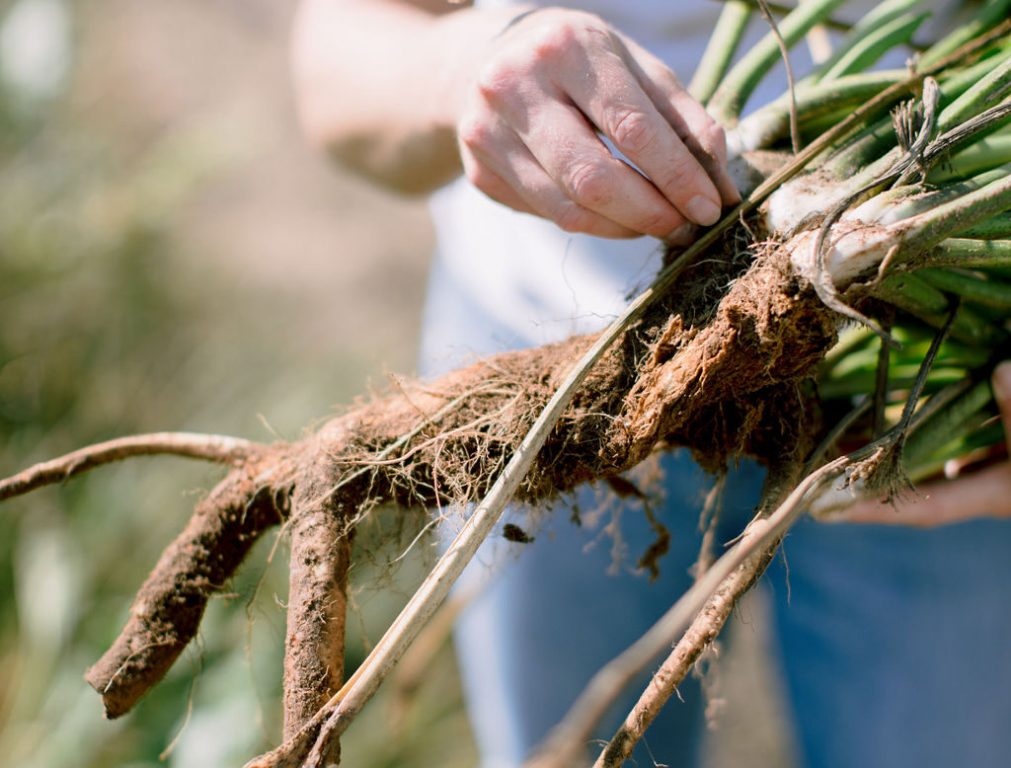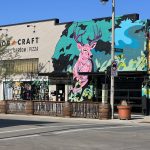Why Wisconsin Leads The Way in Horseradish
Huntsinger Farms the largest grower and processor of horseradish on earth?

Raw horseradish from Huntsinger Farms in Eau Claire. The farm tags itself as the largest grower and processor of horseradish in the world. Photo courtesy of Huntsinger Farms
Walking into the wash room at Huntsinger Farms in Eau Claire, the biting smell of their signature vegetable is apparent.
The Wisconsin farm is home to a global epicenter of horseradish, a vegetable whose first recorded use was over 3,000 years ago. Huntsinger Farms has been around for nearly a century and claims to be the largest grower and processor of horseradish in the world.
December is the end of harvest season. As Huntsinger employees transition to winter, WPR’s “Wisconsin Today” toured the farm to better understand the unusual vegetable.

Kyle Bechel climbs on top a mountain of raw horseradish at the Huntsinger farm in Eau Claire. Mackenzie Krumme/WPR
Wisconsin climate is ideal for growing horseradish
Eric Rygg represents the fourth generation to run Huntsinger Farms, and is president of Huntsinger subsidiary Silver Spring Foods. His great grandfather started the farm in 1929. Rygg said what sets the farm apart is the location with ideal growing conditions.
“We’re at about the 45th parallel so the climate is about perfect,” Rygg said. Horseradish likes the cold winter weather, the long growing season and the soil.
Located on Eau Claire’s south side, the Huntsinger has nearly 1,000 acres of horseradish. The root vegetable is in the ground anywhere from 12 to 24 months. Potatoes, in comparison, are in the ground roughly three months.

Huntsinger Farms in Eau Claire tags itself as the largest grower and processor of Horseradish in the world. The horseradish products are sold domestically but also in Japan, Canada and Europe. Mackenzie Krumme/WPR
The horseradish is stored in two buildings that hold around 4 million pounds of it. Then it’s washed and ground to make various types of sauces for Silver Spring Foods.
There are few other horseradish farms at similar scale to Huntsingers, farm manager Bechel said. Collinsville, Illinois, also considers itself the horseradish capital of the world, with an annual horseradish festival and there are a number of growers in Europe. But the 45th parallel and the location in Eau Claire is really considered a “sweet spot,” he said.
The ‘zing’ factor
The root vegetable is known for having a spicy taste that burns your nose and makes your eyes water. Bechel said the spice level is also an indication of quality.
“The flavor that you taste in horseradish is a defense mechanism,” he said. “[It is] to deter animals from eating it. And once you start to chew the horseradish, it reacts with oxygen and releases that pungent flavor and aroma that you smell and taste.”

Eric Rygg is the fourth generation to run Huntsinger Farms in Eau Claire. From left to right: Ellis Huntsinger in 1950s and great grandson Eric Rygg in 2024. Photo courtesy of Huntsinger Farms
Silver Spring Foods has developed a heat index for horseradish similar to the Scoville scale, which measures the spiciness of peppers. But instead of measuring for capsaicin, they measure for Allyl isothiocyanate.
They call this the “Zing Factor.”
A group of eight sensory scientists known as “Zing Masters” (a trademarked term) taste and test the products, then label them on a scale of one to five — with five being the zingiest.
Rygg said the horseradish products they offer with the most zing are often the most simple, like their prepared horseradish.
Before horseradish can be processed and made into sauces, however, it has to be handled by people as it is known as one of the most labor intensive crops.
Labor intensive crop that requires specialized equipment
Each year, Huntsinger employees cut roughly 4 million seeds and then plant them, Bechel said. Similar to potatoes, the seeds — better known as fruits — are snippets of the actual vegetable.
Bechel describes operating “the planter” as a 10-person operation:.
“As the planter drives through the field, there’s a little bell on there that dings. And every time that the bell dings, the guys that are planting grab a seed and drop it down that tube and into the ground,” Bechel said.
He said they plant roughly 25 to 30 acres a day. Because the unique shape of horseradish, the machinery at Huntsinger Farms has to be custom built.

Horseradish is known as one of the most labor intensive crops. At Huntsinger Farms in Eau Claire workers inspect the root vegetable by hand. Mackenzie Krumme/WPR
Their planter was originally a potato planter. And their harvester was custom built in 1999. It’s loosely based on a potato planter and still in use today.
The work at Huntsinger requires about 50 full time and seasonal employees. Some people help with harvest and some help with cleaning — each root is inspected and any blemishes are removed by hand.
In other words, it takes many fingers to bring you the zingers.
“People know about our horseradish, but they don’t realize everything that goes into it,” Bechel said. “And I think that’s true for most products that you consume, there’s a lot of behind the scenes that people don’t realize.”
Why Wisconsin is a global horseradish powerhouse was originally published by Wisconsin Public Radio.
If you think stories like this are important, become a member of Urban Milwaukee and help support real, independent journalism. Plus you get some cool added benefits.





















I wondered why my horseradish did do much better than the rest of my garden.
Why can’t that “Zinger” scale be listed on each bottle? I’m always seeking a “5” but it’s hit or miss, and seems like it’s a lot milder today than a few years ago.